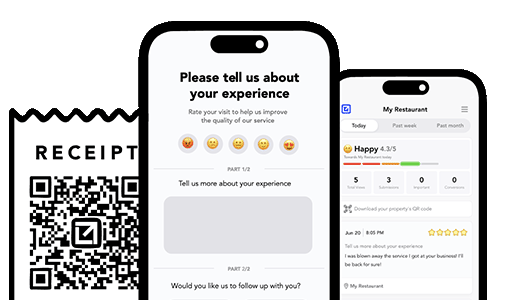Smart Ways to Get More Reviews [Guide]
Practical, proven ways for any business to get more authentic reviews.

TLDR: Improving your Yelp rating isn’t about shortcuts, it’s about strategy. Yelp is critical for local visibility, especially because Apple Maps pulls its data directly from Yelp. If your Yelp score is low or your review volume is sparse, you’re losing customers before they even find your door. This guide explains why Yelp reviews matter more than ever, why many reviews get filtered, and exactly how to boost your rating the right way. From fixing root problems in your business to using private feedback funnels and review prompts that comply with Yelp’s policies, we’ll cover every step. Plus, you’ll learn how real-time feedback intercepts unhappy customers before they blast you online. For businesses serious about reputation management in 2025, this is the playbook.
Most businesses obsess over Google reviews, and they should, but Yelp carries unique weight that too many overlook. Here’s why: Apple Maps, which is the default navigation app for over 100 million iPhone users in the U.S., relies almost exclusively on Yelp for ratings and reviews. That means if you have a strong Google profile but a weak Yelp presence, you’re still invisible to a massive portion of your potential customers.
A low Yelp score doesn’t just affect your visibility, it affects trust. Travelers, diners, and shoppers who rely on Yelp or Apple Maps will often make decisions instantly based on star ratings. Worse, Yelp listings frequently appear in the first few organic results for local searches, meaning it’s often the first impression you make online. In short, ignoring Yelp is leaving money, and customers, on the table.
Here’s a painful truth: Yelp’s algorithm aggressively filters reviews it suspects are “solicited” or inauthentic. If you ask customers directly for reviews in a way that sounds pushy, or worse, offer incentives, those reviews might never see the light of day. They’ll be marked as “Not Recommended” and hidden from public view. Even genuine reviews can get filtered if the reviewer is new to Yelp or leaves only a single review.
This is where so many businesses go wrong. They assume more asks = more reviews, but if Yelp detects a pattern of “forced” reviews, your account could face penalties. The result? A ton of wasted effort and no improvement in your score.
Improving your Yelp profile starts inside your business, not online. Before you chase reviews, fix the fundamentals:
Bad reviews often come from avoidable pain points: unclean restrooms, rude staff interactions, or confusing policies. Audit your customer experience regularly, because no amount of review strategy can cover for operational failures.
Instead of asking customers to review you publicly right away, start by asking for feedback privately. This lets unhappy customers vent without broadcasting it online, and gives you a chance to fix things. Once you identify happy customers, gently encourage them to share their experience on Yelp.
When you do get a negative review, respond promptly with empathy. Public responses aren’t just for the reviewer, they signal to everyone else that you care about your customers. Offer a genuine apology and a clear solution.
Use signage like “Love your experience? Share it on Yelp!” at key touchpoints. Add subtle reminders on receipts or in follow-up emails. The key is to make it feel optional, not forced.
Prevention beats damage control every time. Real-time feedback loops allow you to identify problems immediately, before the customer turns to Yelp to vent. A QR code near your checkout counter or an SMS after a visit makes it easy for customers to share frustrations privately. Once you know the issue, you can resolve it and turn what could have been a 1-star disaster into a loyal customer story.
VisibleFeedback takes all the guesswork out of this process. Here’s how:
A higher Yelp rating starts before the review goes live. Use VisibleFeedback to collect feedback, recover issues, and grow your reputation the right way. 👉 Start Your Free Trial Today

Bad reviews can scare away potential customers. Intercept feedback in real time with VisibleFeedback.

Austin Spaeth is the founder of VisibleFeedback, a simple tool that helps brick-and-mortar businesses intercept negative reviews before they go public. With a background in software development and a passion for improving customer experience, Austin built VisibleFeedback to give business owners a frictionless way to collect private feedback and turn unhappy visitors into loyal advocates. When he’s not working on new features or writing about reputation strategy, he’s probably wrangling one of his six kids or sneaking in a beach day.
Whether you have no reviews, bad ones, or great ones, we’ll help you turn your feedback into growth.
No credit card required.
⛨ Trusted by over 137 local businesses like yours